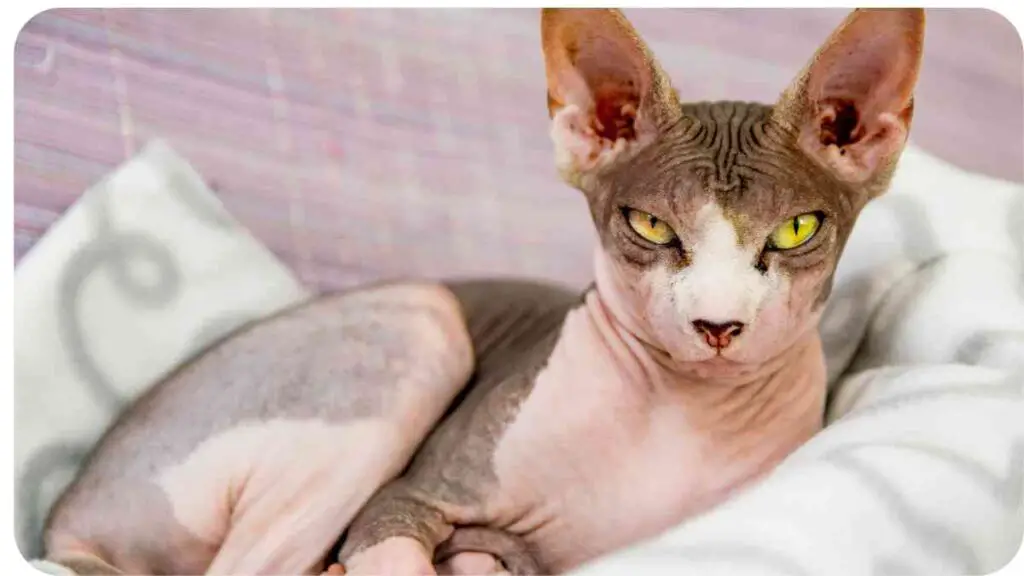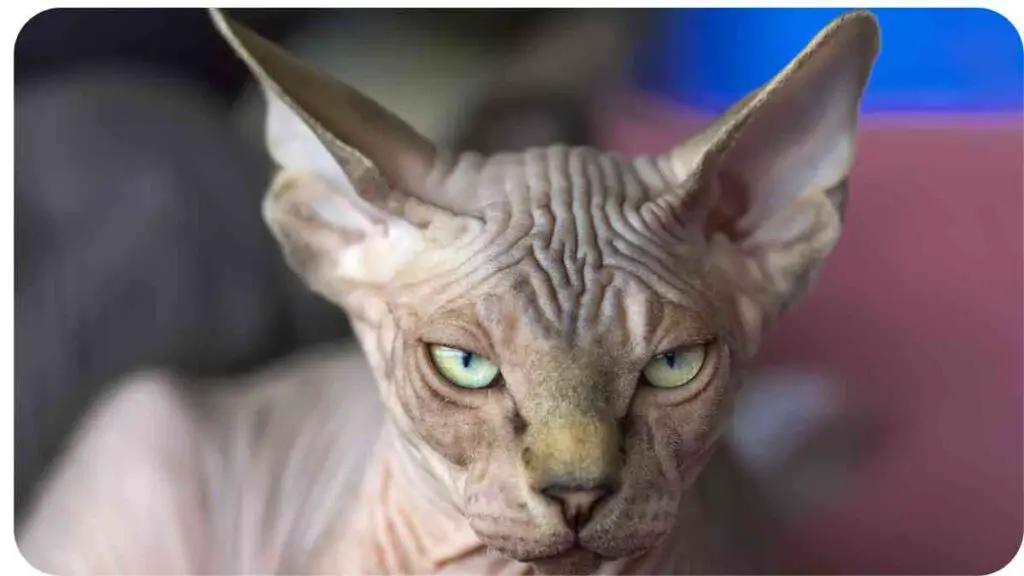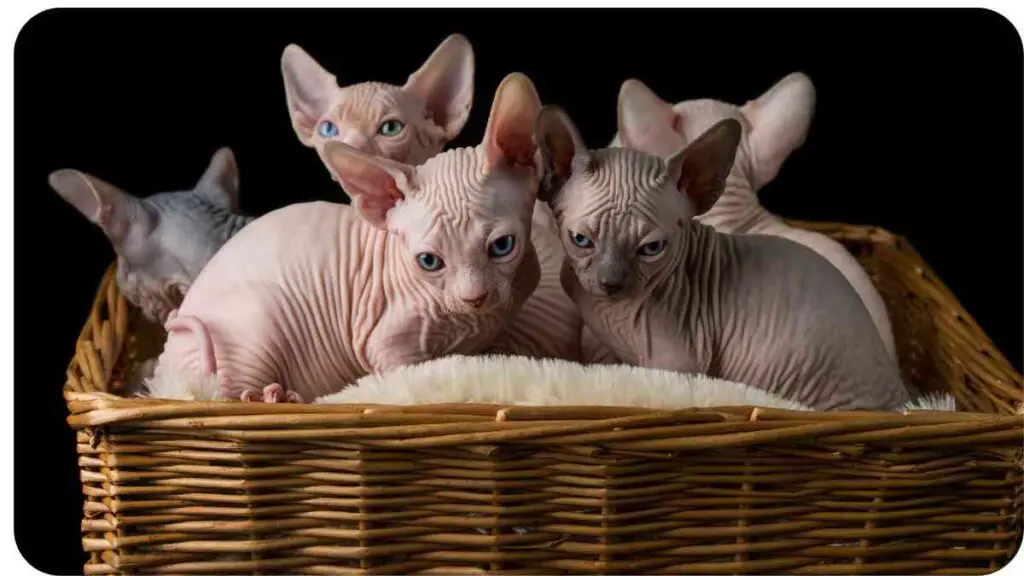If you’ve ever wondered why Sphynx cats feel warmer than other breeds, this article provides comprehensive insights. Discover the unique characteristics of these furless felines, from their lack of body fat to their playful nature, contributing to their elevated body temperature.
Learn practical tips to keep your Sphynx cat comfortable and healthy, whether you’re a proud owner or considering adopting one. Dive into the details below to unravel the mysteries behind the warmth of Sphynx cats and ensure optimal care for your beloved companions.
| Takeaways |
|---|
| Sphynx cats feel warm due to their lack of fur. |
| The absence of fur allows their body heat to be more noticeable. |
| Sphynx cats have a higher body temperature compared to other cats. |
| Their warmth is a natural characteristic of the breed. |
| Proper environmental conditions can help them stay comfortable. |
Sphynx Cats

Sphynx cats, renowned for their distinctive appearance, possess an equally remarkable trait – an immense love for cuddling. If you’re a cat enthusiast who revels in snuggling, the Sphynx could be your perfect feline companion.
These affectionate cats go beyond mere companionship; they actively seek out opportunities to curl up in your lap or join you on the couch. What sets them apart is their furless skin, making them ideal lap cats. Unlike other breeds whose fur may irritate sensitive skin, the Sphynx’s smooth and hairless exterior eliminates this concern.
Furthermore, families with children find Sphynx cats to be excellent companions. The absence of fur reduces the likelihood of causing skin irritation, and bonus – no hairball issues to contend with!
As a delightful addition, Sphynx cats seamlessly integrate into households with other pets or family members. Whether you have a dog, rabbit, or another human companion, the Sphynx’s sociable nature ensures harmonious coexistence.
For families with allergies, the Sphynx emerges as a top choice. Their furless nature means minimal shedding, translating to fewer allergens and a reduced likelihood of triggering allergic reactions. Embrace the warmth and affection of a Sphynx cat – a loving, hypoallergenic addition to your family.
Maintaining proper hygiene is essential for Sphynx cats. Learn more about how often Sphynx cats need to be bathed and ensure your feline friend stays clean and healthy.
The Unique Coat of Sphynx Cats
The distinct charm of Sphynx cats lies not only in their hairless appearance but also in the warmth they exude – quite literally. Owners often observe that their Sphynx companions feel warmer compared to cats with fur, and the reason lies in their very short coat and the absence of hair follicles.
Unlike their furry counterparts, Sphynx cats lack the ability to shed their coat, which contributes to their distinctive feel. This unique feature means they retain more body heat, making them warmer not just in winter but also during the summer months.
However, this thermal characteristic comes with a caveat: Sphynx cats are particularly sensitive to hot weather. In regions with warm climates, it becomes crucial for owners to actively manage their feline friends’ temperature. Providing ample shade, ensuring proper hydration, and, when necessary, moving them indoors during peak heat hours safeguards Sphynx cats from the potential discomfort associated with high temperatures.
| Coat Length | Coat Description |
|---|---|
| Very short | Almost no fur present, minimal hair covering the body |
| Fine texture | Soft, delicate hair texture |
| Sparse | Hair is not dense, limited coverage on the body |
| Wrinkled skin | Skin may have folds and wrinkles |
| Oily | Skin produces natural oils to compensate for lack of fur |
Sphynx Cats and the Heat Conundrum

Encountering a Sphynx cat often leads to a peculiar observation – their bodies feel notably warmer, akin to touching a hot stove. The key to understanding this thermal distinction lies in the realm of body fat and its crucial role in temperature regulation.
In typical feline physiology, body fat serves a dual purpose: insulation and energy storage. Not only does it provide a protective layer, but it also plays a vital role in regulating internal temperature. Body fat can efficiently store excess heat generated by internal organs or release it when needed to maintain optimal warmth.
Contrastingly, Sphynx cats present a distinctive case with minimal body fat. This characteristic sets them apart from other cat breeds, impacting their ability to regulate temperature effectively. With little insulation and energy storage, Sphynx cats lack the mechanisms that enable them to modulate their body temperature with the precision seen in their furry counterparts.
Curious about the ideal bathing frequency for Sphynx cats? Our article on how often you should wash a Sphynx cat provides valuable insights and tips to keep your hairless companion feeling fresh and cozy.
Dynamic Companions
The Sphynx cat stands out not only for its distinctive appearance but also for its vibrant and energetic demeanor. Renowned as a highly active breed, Sphynx cats thrive on engaging in playful activities and sharing affection with their human companions.
Their lively nature extends beyond interactions with humans – Sphynx cats exhibit remarkable affection towards other animals, fostering harmonious relationships within multi-pet households. This breed’s intelligence is evident as they quickly grasp concepts, making them easily trainable for essential activities such as using a litter box or going for a walk outdoors.
Sphynx cats, characterized by their love for human interaction, become ideal additions to homes with children or other pets. Their social nature ensures that they not only tolerate but actively enjoy the company of diverse family members.
Caring for Ailing Sphynx Companions
In times of injury or illness, Sphynx cats may exhibit a noticeable increase in body warmth and, in severe cases, difficulties in breathing. The reason behind this lies in the remarkable resilience of their bodies, actively utilizing energy to mend injuries and combat illnesses, consequently elevating internal temperatures.
When a Sphynx cat is unwell or nursing an injury, the heightened body warmth serves as a physical indicator of their body’s heightened metabolic activity. This increased internal temperature signifies the dedication of their biological resources to the crucial task of recovery.
As vigilant pet owners, it is imperative to remain attuned to signs of distress, especially when a Sphynx cat’s body temperature deviates from the norm. Any notable increase should prompt immediate action – a visit to the veterinarian. Seeking professional care ensures a prompt and accurate diagnosis, guiding appropriate interventions to alleviate discomfort and promote the well-being of the cherished feline companion.
Sphynx Cats and Sighthounds
The intriguing warmth experienced when touching Sphynx cats and sighthounds goes beyond mere perception—it’s rooted in their unique physiology. Unlike other domestic cat breeds with a normal body temperature ranging from 100.5°F [38.1°C] to 102.5°F [39°C], Sphynx cats boast a distinctive thermal profile.
Sphynx cats, renowned for their hairless nature, typically maintain an average body temperature between 103 and 105 degrees Fahrenheit. This variance can be attributed to factors such as age and overall health, making each individual’s temperature slightly different.
The lack of fur, a defining characteristic of Sphynx cats, exposes their skin directly to external conditions, facilitating a more pronounced heat exchange. This increased skin exposure contributes to their perceptible warmth, setting them apart from other feline counterparts.
Similarly, sighthounds share this elevated skin temperature trait. The inherent physiology of these breeds, combined with the absence of insulating fur, results in a tangible difference in touch compared to other domestic cats.
Do you wonder about the average lifespan of Sphynx cats? Discover the factors influencing their longevity in our comprehensive guide on the average life expectancy of a Sphynx cat, and ensure your beloved feline companion enjoys a healthy and fulfilling life.
Ensuring Comfortable Environments for Your Sphynx Companion
Your Sphynx cat’s well-being hinges on maintaining an optimal home environment, where warmth remains a crucial consideration. Recognizing signs of discomfort, such as panting and visible attempts to cool down, indicates that your home may be too warm for your feline friend’s comfort.
To remedy this, adjust your home thermostat to a cooler setting, ensuring a more comfortable temperature for your Sphynx companion. Additionally, promoting air circulation by keeping at least one window open in each room fosters a refreshing breeze, alleviating any stifling heat.
When venturing outdoors, choose grassy areas with ample tree cover to shield your Sphynx cat from direct sunlight. Avoid concrete or asphalt surfaces that retain heat, opting instead for cooler, shaded spots conducive to your cat’s comfort.
Unmasking the Dehydration Dilemma in Sphynx Cats
The seemingly heightened body temperature in Sphynx cats may not be a quirk of their breed but a potential indicator of a more serious concern dehydration.
Dehydration, a significant and sometimes concealed issue, can manifest in Sphynx cats due to various factors such as stress, illness, or dietary issues. Despite appearances, the perceived increase in body temperature may be a symptom of the body’s struggle to maintain its natural balance.
It becomes imperative for vigilant owners to stay attuned to signs of dehydration, especially if accompanied by distress signals like vomiting or visible discomfort. Swift action is paramount in such scenarios, necessitating an immediate visit to the veterinarian. Even if a Sphynx cat appears to be consuming water at home, underlying issues may still persist, warranting professional intervention.
| Effects | Severity |
|---|---|
| Decreased cognitive function | Mild to severe |
| Fatigue and decreased energy levels | Moderate to severe |
| Headache | Mild to moderate |
| Dizziness and lightheadedness | Mild to moderate |
| Dry mouth and increased thirst | Mild to moderate |
| Impaired physical performance | Moderate to severe |
| Dark-colored urine | Mild to moderate |
vigating the Thermal Landscape

The seemingly warmer touch of Sphynx cats, despite environmental conditions, stems from their unique genetic makeup. Like their hairless counterparts, Sphynx cats exhibit a naturally higher body temperature compared to their furry counterparts.
However, this thermal distinctiveness takes an intriguing turn when it comes to the cold. Despite their inherently elevated body temperature, Sphynx cats possess less protection against the cold due to their lack of fur. This peculiarity can create a paradox for owners, who may perceive warmth even when the ambient temperature is not particularly chilly.
The underlying explanation lies in the phenomenon known as “hyperthermia.” This occurs when the body loses heat more rapidly than it can generate, leading to a drop in internal temperature. While this term is commonly associated with extreme environmental conditions, it holds relevance for Sphynx cats due to their reduced insulation against the cold.
When will your Sphynx cat reach full maturity? Find out in our informative article on how long it takes for a Sphynx to be fully grown and gain insights into the growth stages of these unique and affectionate felines.
Temperature Reflections of Emotions
Beyond the influence of environmental temperatures, the body temperature of a Sphynx cat is intricately linked to their emotional well-being. Stress and anxiety can manifest in tangible ways, impacting the thermal dynamics of these unique feline companions.
Signs of stress or anxiety in a Sphynx cat can include panting, seeking seclusion, excessive grooming, and a propensity to gravitate towards heat sources such as warm beds or human bodies. These behaviors serve as indicators of emotional distress, prompting attentive owners to recognize and address potential sources of unease.
Observing a Sphynx cat’s body language and thermal cues provides valuable insights into their emotional state. Panting, in particular, may signal heightened stress levels, while seeking warmth may serve as a coping mechanism.
Creating a conducive and calming environment, identifying stressors, and offering reassurance become pivotal in alleviating the emotional burden on Sphynx cats. By understanding the nuanced connection between emotional well-being and body temperature, owners can foster a supportive atmosphere where their Sphynx companions can thrive emotionally and physically.
| Factors | Impact |
|---|---|
| Work Pressure | High workload, tight deadlines |
| Personal Issues | Relationship problems, financial difficulties |
| Health Concerns | Chronic illness, physical discomfort |
| Lifestyle Habits | Poor sleep, excessive caffeine consumption |
| Environmental | Noisy surroundings, overcrowded spaces |
Winter Warmth for Sphynx Cats
Ensuring the comfort of your Sphynx cat during the winter requires thoughtful measures, and a key strategy involves leveraging their affinity for warmth. Owners seeking ways to keep their Sphynx cats snug in colder months can explore a variety of options.
For immediate warmth, employing a heating pad or a hot water bottle can provide a cozy retreat for your Sphynx companion. These tools offer localized warmth, especially valuable in chillier weather.
However, the true delight for Sphynx cats lies in the art of sunbathing. Renowned for their love of basking in sunlight, these furless felines revel in lounging on window ledges or tables, absorbing the comforting warmth. While moderation is essential, particularly in extreme temperatures, the joy Sphynx cats derive from sunbathing is a testament to their appreciation for natural heat sources.
Considering adding a Sphynx kitten to your family? Explore our guide on the cost of a Sphynx kitten to understand the financial aspects and make an informed decision about welcoming a warm and loving companion into your home.
Conclusion
In the realm of feline companionship, the Sphynx cat stands as a distinctive and captivating breed, demanding a nuanced approach to care. While their hairless appearance and warm touch make them a unique presence, it’s essential to note that Sphynx cats don’t require fundamentally different treatment than their furry counterparts.
The key consideration in the care of Sphynx cats revolves around their susceptibility to heatstroke in warmer weather due to their lack of fur. This singular vulnerability underscores the importance of temperature-conscious care, ensuring that they are shielded from excessive heat and provided with ample opportunities for cooling.
Acknowledging and accommodating this specific need becomes the cornerstone of responsible Sphynx cat care. By prioritizing a climate-appropriate environment, employing warmth strategies in colder months, and staying attuned to signs of distress or discomfort, owners can foster a thriving and contented life for their unique, furless feline companions.
In essence, caring for a Sphynx cat involves celebrating their individuality while understanding and addressing their distinctive thermal requirements. With this mindful approach, the bond between owner and Sphynx cat flourishes, creating a harmonious companionship that embraces the warmth—both literal and figurative—of this extraordinary breed.
Further Reading
First Sphynx Kitten Feels Very Warm: Explore a community discussion on why a first-time Sphynx kitten owner noticed their kitten feeling warm and seek insights from fellow Sphynx cat enthusiasts.
Why Are Sphynx Cats Always Hot to the Touch?: Discover the reasons behind the consistently warm body temperature of Sphynx cats and learn more about their unique physiology.
Feeling Hot to the Touch: Is it a Fever in Sphynx Cats?: Find expert advice and explanations regarding the perceived warmth of Sphynx cats and whether it indicates a potential fever.
Now, let’s move on to the FAQs section:
FAQs
What causes Sphynx cats to feel warm to the touch?
Sphynx cats lack a fur coat, which plays a significant role in regulating body temperature. As a result, their body heat is more noticeable, and they may feel warmer to the touch compared to cats with fur.
Is it normal for Sphynx cats to feel warmer than other cat breeds?
Yes, it is normal for Sphynx cats to have a higher body temperature compared to other cat breeds. Their lack of fur means that their skin is directly exposed, leading to increased heat transfer and making them feel warmer to the touch.
Does the warmth of a Sphynx cat indicate a health issue?
Not necessarily. While Sphynx cats naturally have a higher body temperature, it’s essential to monitor any additional signs of illness or discomfort. If you have concerns about your Sphynx cat’s health, it’s best to consult with a veterinarian.
How can I help my Sphynx cat stay comfortable if they feel too warm?
Providing a temperature-controlled environment with appropriate ventilation can help keep your Sphynx cat comfortable. Additionally, ensuring access to fresh water and a balanced diet can contribute to their overall well-being.
Are there any health conditions specific to Sphynx cats that can cause excessive warmth?
Sphynx cats are generally healthy but may be more prone to certain conditions like hypertrophic cardiomyopathy (HCM) and respiratory infections. If you notice any changes in your Sphynx cat’s behavior or health, consult a veterinarian for a proper diagnosis and treatment.

I’m Dr. Hellen James, a veterinarian who has spent her career working with cats and has seen firsthand how important it is to understand each breed’s unique needs.


